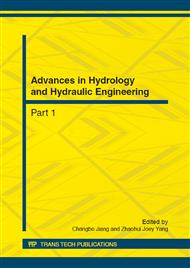p.518
p.525
p.531
p.536
p.543
p.549
p.554
p.560
p.564
River System Connectivity Analysis of Wuxi’s Central Urban Area Based on Graph Theory
Abstract:
Wuxi City is located in the hinterland of Taihu Basin and an important city in Yangtze River Delta Region with a prosperous economy. In the process of urban development, the river system pattern changes a lot. It has an impact on water environment, water ecology and other fields. The central urban area of Wuxi City was selected as the study area. Based on the river system of three periods: 1960s, 1980s and 2009, the rivers were classified into three levels according to the width of channels. The length, acreage and stream structure parameters were calculated. Then from the view of Graph Theory, river system was expressed as network graph, and the vertices, edges and degree of vertices were analyzed. The results show that the changes of rivers of different levels and lakes are not completely the same, but still appear a decreasing trend in general. The river network density and water surface ratio become smaller. Also the complexity and structure stability of river network weaken. The conclusions that the river evolution tends to be trunk and single, the stream structure is simplified and the connectivity of rivers and lakes reduces are verified by the analysis based on Graph Theory as well.
Info:
Periodical:
Pages:
543-548
Citation:
Online since:
October 2012
Authors:
Price:
Сopyright:
© 2012 Trans Tech Publications Ltd. All Rights Reserved
Share:
Citation:


